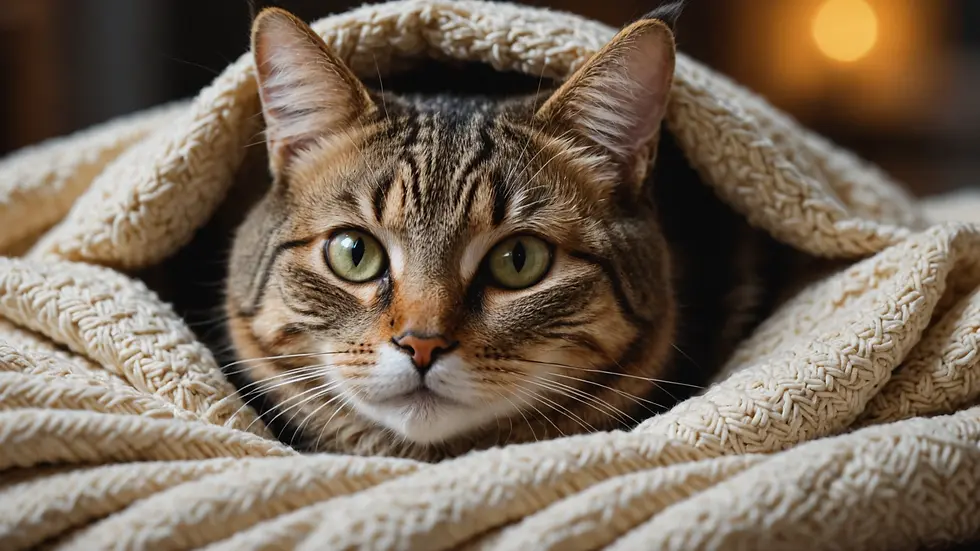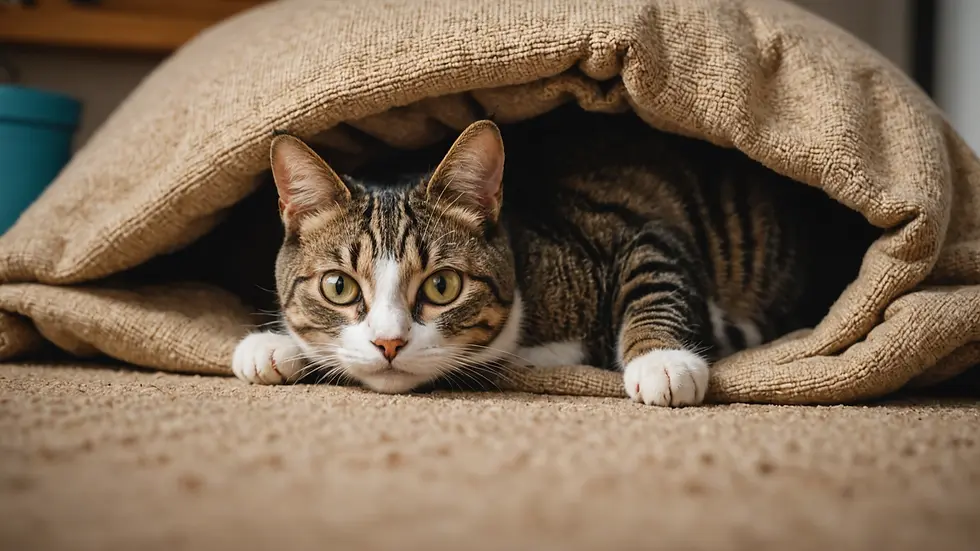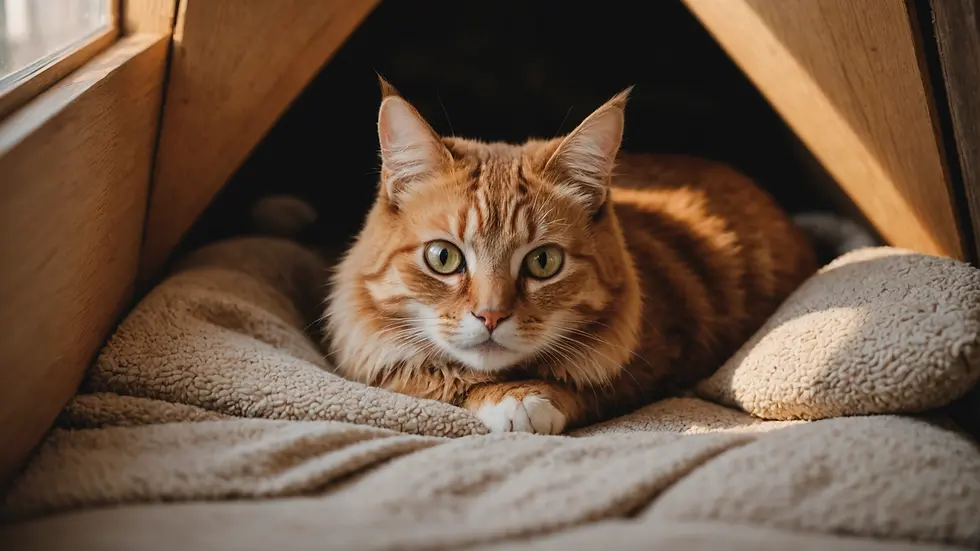Why Do Cats Disappear into the Shadows? Exploring the Mysterious World of Feline Hiding
- Jyotiraj Borah
- Feb 7
- 5 min read
Cats are captivating creatures that have captured the hearts of pet owners and animal lovers for generations. Their playful antics, soothing purrs, and sometimes baffling behavior keep us intrigued. One of the most puzzling aspects of feline behavior is their tendency to hide. Whether it’s behind the couch, under the bed, or in a cozy corner, a cat’s urge to retreat can leave us searching in confusion. Understanding why cats hide not only reveals their behaviors but also strengthens our bond with them.
Understanding Feline Instincts
Cats are natural hunters. This instinct comes from their wild ancestors, who relied on stealth to catch prey. Even domestic cats exhibit similar behaviors. Hiding allows cats to observe their surroundings without being noticed, just like predators do in the wild. A study by the Animal Behavior Society found that over 70% of cats prefer to stay low to the ground, which supports their instinctual need to stay hidden.
In addition to observing, hiding provides a sense of security. In the wild, being exposed makes cats vulnerable to predators. This instinct drives many domestic cats to seek out confined spaces or obscure areas in your home, where they feel less at risk and more at ease.
Safety and Security in Hiding
Feline hiding can relate to safety and anxiety. Cats thrive on routine and can feel stressed with changes in their environment. Noisy blasts from construction outside, unfamiliar visitors, or even a new pet can trigger stress levels. According to the ASPCA, up to 30% of cats are sensitive to disruptions in their environment. In those moments, they often retreat to their hiding spots to regain a sense of control.
Identifying a cat’s anxiety signals is vital for effective support. Signs may include excessive grooming, loss of appetite, or aggression. Gently encouraging them out of hiding and being available for comfort can make a significant difference.
The Role of Temperature and Comfort
Cats are temperature-sensitive animals. Their hiding behavior often aligns with their need for comfort. In warmer months, a cat might prefer hiding in a cool, shaded space, while colder months lead them to seek warmth—often curling up in small spots where they can trap heat.
Comfort also plays a significant role in their choices. Cats love soft, cushioned areas. Providing warm, cozy beds in quiet corners can allow your cat to hide in a way that feels satisfying and reduces anxiety.

Curiosity and Playfulness
Cats are naturally curious. Hiding can also be a part of their playful behavior. Simple items like boxes or paper bags can become irresistible hideaways, encouraging a playful "hide-and-seek" game with themselves or their owners. An estimated 70% of cats enjoy exploring confined spaces, confirming that hiding is woven into their playful nature.
To stimulate their curiosity while providing safety, you can set up fun hiding spots using soft tunnels or cat caves. These areas encourage exploration and play while catering to their need for personal space.
Sleep and Resting Behavior
Cats need substantial sleep—averaging 12 to 16 hours daily. Finding a secluded spot allows them to rest without disturbances. As instinctively alert beings, they often choose areas that keep them hidden from threats. For example, a cat resting on a higher shelf or behind a curtain feels more secure and less exposed.
Designating a specific quiet area for rest can promote a healthy sleep routine. Consider providing a resting space equipped with soft bedding, making it comfortable and inviting, helping your cat recharge effectively.
Overnight Hiding Tendencies
Pet owners often notice their cats engage in different hiding patterns at night. Cats are crepuscular, meaning they are most active at dawn and dusk. As night falls, they may instinctively hide, blending into the shadows. Observing this behavior can reveal interesting activity patterns. Typically, periods of hiding are followed by bursts of energy, emphasizing their instinctual blend of caution and playfulness.
Combining Curiosity with Caution
Though most hiding behaviors result from instinct or comfort, sometimes cats retreat when stressed. Illness or injury can lead to a sudden desire to hide. If your cat's behavior changes abruptly or they start hiding more than usual, it’s essential to consult a veterinarian to rule out health problems. For instance, a sudden retreat for a usually active cat could signal pain or discomfort, requiring attention.
Keeping an eye on behavioral changes can help you catch potential issues early. Minor shifts, such as increased hiding or decreased interaction, could be signs that something is wrong. A good relationship with your vet can ensure a long, happy life for your feline companion.
The Social Bond: Recognizing and Respecting Their Space
It's essential for cat owners to understand that cats will seek solitude sometimes. They enjoy our company but also need their personal space. This balance cultivates a healthy relationship. Creating an environment with opportunities for both play and quiet time allows cats to feel secure.
Choose various hiding spots for your cat, such as cardboard boxes or soft beds. This way, they can retreat whenever they need, providing an essential safety net in their environment.

Creating a Cat-Friendly Environment
To support your cat's natural inclination to hide, consider adjusting your living space. Here are a few tips:
Designate safe spaces: Create specific areas with soft beds, pet tunnels, or blankets that can serve as retreat spots for your cat.
Limit disturbances: Provide quiet areas in your home where your cat can go with minimal interruptions.
Respecting Your Cat's Privacy
Respecting your cat's wish to hide is vital. Forcing them to come out can cause stress. Instead, give them the freedom to choose when to engage. Seek to understand their preferences through gentle interactions, respecting their need for solitude.
Engaging in gentle play when they emerge and providing affection on their terms can deepen the bond between you and your cat. This approach encourages trust while acknowledging their instincts.
The Importance of Understanding Feline Behavior
Understanding why cats hide gives valuable insights into creating a harmonious environment for everyone. Recognizing that this behavior originates from deep-rooted instincts, safety needs, and the quest for comfort allows cat owners to create secure and inviting spaces.
Cats are more than just pets—they are emotionally complex beings with unique needs. Acknowledging their preferences and behaviors strengthens the emotional bond that leads to a happy life for both you and your cat.
Final Thoughts on Feline Hiding Behavior
The behavior of cats hiding reflects their instinctual needs for safety and comfort. It reminds us that while cats are playful and independent, they also need spaces to feel secure. As you foster this balance in their environment, your cat will thrive in both play and relaxation.
In every hidden spot lies a story of curiosity or a peaceful retreat. Embracing their natural hiding behavior nurtures a more profound understanding of your feline friend, helping you appreciate the captivating, elusive world they inhabit.





Comentarios